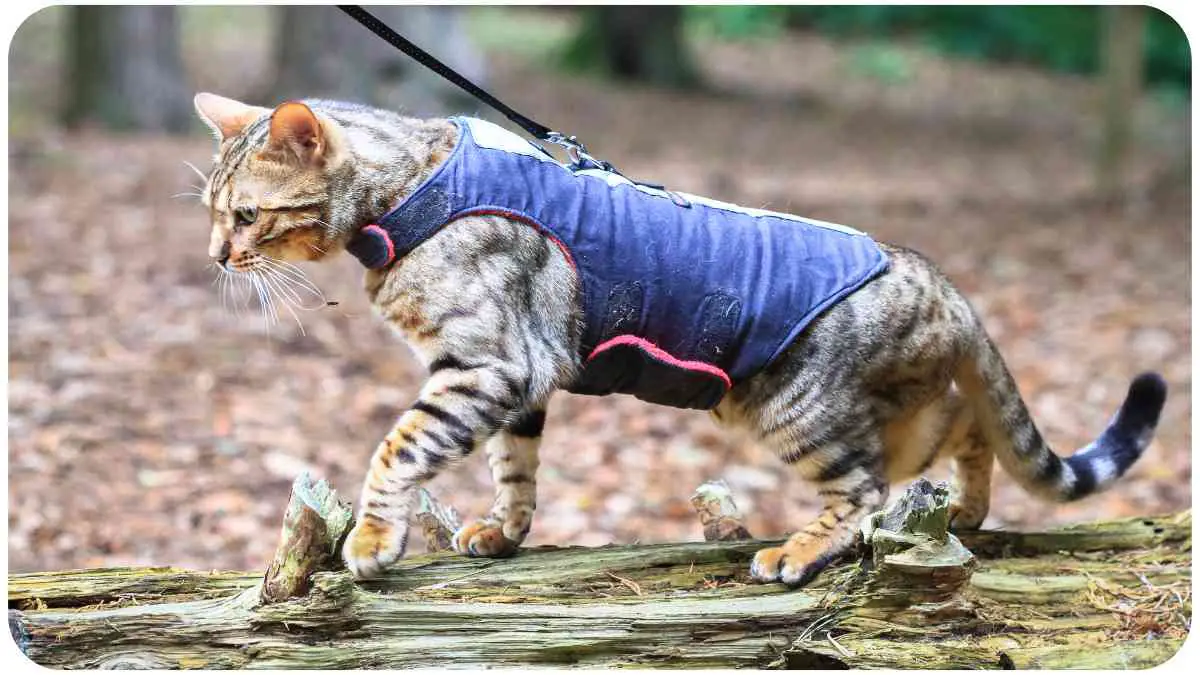Hey there, fellow feline enthusiasts! If you’ve ever gazed out your window and seen a world of adventure awaiting your indoor cat, you’re not alone. While our furry friends are often content lounging indoors, they can also benefit from a taste of the great outdoors.
That’s where the “Come with Me Kitty Harness” steps in as a game-changer. In this guide, I’ll walk you through the ins and outs of harness training for cats, leveraging my own journey and expertise to help you create a secure and enjoyable outdoor experience for your beloved feline companion.
| Takeaways |
| Harness training enriches your cat’s life and strengthens the bond between you. |
| The “Come with Me Kitty Harness” offers a secure and comfortable option for outdoor exploration. |
| Introduce the harness gradually, using positive reinforcement to create a positive association. |
| Patience and understanding are essential throughout the training process. |
| Gradually progress from indoor training to supervised outdoor walks. |
| Harness training timeline varies; adapt to your cat’s pace. |
| Overcome challenges like leash pulling by using positive reinforcement techniques. |
| Monitor your cat’s reactions and provide comfort in new environments. |
| Building trust and creating positive associations lead to successful harness training. |
| Expertise in feline behavior and practical knowledge enhance your training approach. |
| Customer reviews and authoritative resources provide valuable insights. |
Understanding the Come with Me Kitty Harness
Before we dive into the nitty-gritty, let’s take a moment to understand what makes the “Come with Me Kitty Harness” a go-to choice for cat owners. This specially designed harness combines comfort and control, ensuring your cat’s safety while exploring the world beyond your home. The harness features a snug yet gentle fit, preventing your cat from easily slipping out while allowing freedom of movement.
Training your cat to walk on a leash can be a rewarding experience. Begin with essential leash training techniques to ensure a comfortable and enjoyable outdoor adventure for both you and your feline friend.
Table: Comparison of Top Harness Brands
| Brand | Features | Material | Sizes Available |
| Come with Me Kitty | Secure fit, gentle control, escape-proof | Soft nylon | S, M, L |
| Purrfect Paws Harness | Adjustable, figure-eight design | Mesh fabric | XS, S, M, L, XL |
| Kitty Adventure Vest | Reflective, durable, all-weather | Polyester | S, M, L |
Understanding the Benefits of Harness Training for Cats

Venturing outdoors provides numerous benefits for your indoor cat. Fresh air, sensory stimulation, and supervised exploration contribute to a happier and more enriched life. But wait, there’s more! Let’s break down the advantages of harness training:
- Mental Stimulation: Outdoor experiences engage your cat’s senses, keeping them mentally sharp and curious.
- Physical Activity: Exploring the environment encourages exercise, vital for maintaining a healthy weight and muscles.
- Bonding Opportunity: Shared adventures foster a stronger bond between you and your cat.
- Reduced Boredom: Outdoor excursions minimize indoor boredom, decreasing the likelihood of destructive behavior.
Selecting the Right Harness
Choosing the perfect harness is akin to selecting a comfy outfit for your furry friend. The “Come with Me Kitty Harness” comes in different sizes, ensuring a snug fit that won’t hinder movement. Always measure your cat’s girth before purchase to guarantee the right size. Remember, comfort is key!
Stay tuned for more as we delve into the step-by-step process of introducing the harness to your cat. Harness training might seem daunting, but with the right approach and a sprinkle of patience, you’ll soon be strolling with your feline sidekick by your side.
Maintaining a harmonious home involves teaching your cat good habits. Explore effective methods for keeping your cat off counters and tables to create a cat-friendly environment and prevent unwanted behaviors in shared spaces.
Step-by-Step Guide to Introducing the Harness
Understanding Your Cat’s Behavior
Every cat has a unique personality, and their reactions to new experiences can vary. Some felines might be naturally curious, while others could be initially hesitant. Before diving into harness training, take a moment to observe your cat’s behavior. Are they comfortable wearing accessories, or do they tend to be more reserved? This insight will help you tailor your approach to their comfort level.
Familiarizing Your Cat with the Harness
Introducing the harness gradually is key. Place the harness near your cat’s favorite resting spots to familiarize them with its presence. Let them sniff and investigate it at their own pace. Incorporate positive reinforcement offer treats and affection when they show interest in the harness. This creates a positive association, making the harness a symbol of good things to come.
Putting on the Harness Properly
Now comes the exciting moment: putting on the harness! Start by gently draping the harness over your cat’s back without fastening it. Allow them to get accustomed to the sensation. Gradually progress to fastening the harness for short periods.
During this initial phase, distract your cat with play or treats to divert their attention from the new experience. Keep the first few sessions brief to prevent overwhelming them.
Calling your cat and having them respond is possible with the right approach. Follow this step-by-step guide to train your cat to come when called, fostering a stronger bond and ensuring their safety in various situations.
Table: Progression of Harness Introduction
| Session | Activity | Duration |
| 1 | Letting cat sniff and investigate harness | 5 minutes |
| 2 | Draping harness over cat’s back | 3 minutes |
| 3 | Fastening harness briefly and distracting cat | 2 minutes |
Patience and Positive Reinforcement
Harness training requires patience lots of it! Celebrate small victories. Did your cat wear the harness without fuss? Give them a treat and a gentle petting session. As your cat becomes more accustomed to the harness, gradually increase the time they wear it. Remember, this is a journey, not a race.
Taking Your Cat Outside: The First Exploration
Once your cat is comfortable wearing the harness indoors, it’s time for the grand adventure: outdoor exploration! Choose a calm, enclosed area for the first outing. Keep the leash loose, allowing your cat to lead the way. Supervise their interactions with the environment, ensuring their safety. Observe their reactions and reassure them if they seem unsure.
Bust common misconceptions about feline behavior with this comprehensive guide. Separating fact from fiction, debunk 15 cat training myths will empower you to make informed decisions and build a deeper understanding of your cat’s unique personality and needs.
Table: Outdoor Exploration Checklist
| Checklist Item | Details |
| Choose the Right Location | Opt for a quiet, enclosed area away from traffic |
| Keep Leash Loose | Allow your cat to explore at their own pace |
| Offer Reassurance | Provide verbal encouragement and gentle pats |
| Watch for Signs of Discomfort | If your cat appears anxious, consider ending the session |
Stay tuned as we delve into advanced harness training techniques and address common challenges in our next section. Harness training isn’t always smooth sailing, but with dedication and understanding, you and your cat will navigate any obstacles together.
Advanced Harness Training: Overcoming Challenges

Dealing with Leash Pulling
It’s not uncommon for cats to resist the concept of being led by a leash. If your feline friend starts pulling or trying to escape, resist the urge to tug back. Instead, stop and wait. Once your cat eases the tension on the leash, offer treats and encouragement. This teaches them that walking without tension is rewarding.
Navigate the world of cat training with confidence by learning the dos and don’ts. This guide on the dos and don’ts of cat training provides valuable insights into fostering positive behaviors, creating a harmonious home, and strengthening the bond between you and your feline companion.
Navigating Different Environments
As your cat gains confidence, they might encounter new challenges, like encountering other animals or unexpected noises. Stay vigilant and ready to comfort them. If your cat seems overwhelmed, gently scoop them up and return to a familiar space. Remember, your presence is a source of security.
Table: Strategies for Navigating New Environments
| Challenge | Strategy |
| Encounter with Other Animals | Maintain a safe distance and use treats to redirect focus |
| Startling Noises | Comfort your cat and speak reassuringly |
| Signs of Overwhelm | Retreat to a quieter area and provide comfort |
Tips from Personal Experience: What I’ve Learned
Harness training is a journey that has taught me a lot about my furry companions. Building trust and bonding takes time. In my experience, dedicating a few minutes each day to harness-related activities creates positive associations. Before I knew it, my cats were excited to see the harness!
Creating Positive Associations
Incorporate the harness into playtime or mealtime. Leave the harness nearby while engaging in activities your cat loves. This associates the harness with enjoyable experiences, making it less intimidating.
The Role of Expertise in Successful Harness Training
Harness training is an art that requires expertise. By understanding feline behavior and combining it with practical knowledge, you can guide your cat toward becoming a confident explorer. Trust in your ability to read your cat’s cues and adapt your approach accordingly.
Next, let’s address common questions about harness training and showcase customer reviews of top harness brands. Stay tuned for more insights and helpful information!
Frequently Asked Questions (FAQs)
Can Any Cat Be Harness Trained?
While most cats can be harness trained, individual personalities play a role. Some cats take to the harness quickly, while others may need more time to adjust. Patience and a gradual approach are key. Keep in mind that older cats might require extra patience and gentleness during the training process.
Is It Safe to Use a Harness on Cats?
When used correctly, harnesses are safe for cats. However, it’s essential to choose a well-fitting harness and supervise outdoor excursions. Regularly inspect the harness for wear and tear. Never leave your cat unattended while wearing a harness, as they might get tangled or caught on objects.
How Long Does It Take to Harness Train a Cat?
The time it takes to harness train a cat varies. Some cats might adapt within a couple of weeks, while others might need a few months. The key is to progress at your cat’s pace. Rushing the process can lead to anxiety and resistance.
Table: Harness Training Timeline
| Weeks into Training | Milestones Achieved |
| 1-2 | Comfortable with harness indoors |
| 2-4 | Wearing harness for longer periods indoors |
| 4-6 | First successful outdoor exploration |
| 6-8 | Confidently exploring different environments |
Customer Reviews: Top Harness Brands
Let’s take a moment to hear from cat owners who have experienced harness training firsthand. These reviews shed light on the effectiveness of different harness brands:
- Come with Me Kitty Harness: “The Come with Me Kitty Harness truly lives up to its promise. My cat was a bit skeptical at first, but the gentle fit and secure design made her feel comfortable. Now, our outdoor walks are a daily delight!”
- Purrfect Paws Harness: “The figure-eight design of the Purrfect Paws Harness provides excellent control. My adventurous cat took to it surprisingly quickly. I appreciate the adjustability that ensures a perfect fit.”
- Kitty Adventure Vest: “The Kitty Adventure Vest is a game-changer for my nervous cat. Its reflective features provide added safety during evening strolls. The durable material withstands various weather conditions.”
In conclusion
harness training opens up a world of possibilities for your indoor cat. By understanding your cat’s behavior, introducing the harness patiently, and using positive reinforcement, you’ll foster a strong bond and create enjoyable outdoor experiences.
Remember, harness training is a journey that requires dedication, but the rewards are well worth it. As you embark on this adventure with your feline friend, you’re not just training them you’re building memories that will last a lifetime. So grab that harness, embrace the journey, and watch your cat flourish in the great outdoors. Happy exploring, fellow cat enthusiasts!
Further Reading
Explore these resources to deepen your understanding of harness training and ensure a successful experience for you and your feline friend:
- Come with Me Kitty Harness and Bungee Leash – PetSafe Discover the official product page for the “Come with Me Kitty Harness.” Learn more about its features, benefits, and how it can enhance your cat’s outdoor adventures.
- How to Use Your Come With Me Kitty Cat Harness and Bungee Leash – PetSafe This step-by-step guide from PetSafe provides detailed instructions on how to properly use the “Come with Me Kitty Harness” and bungee leash for effective and safe training.
- PetSafe Come With Me Kitty Harness and Bungee Leash on Amazon Check out customer reviews and ratings for the “Come with Me Kitty Harness” on Amazon. Gain insights from other cat owners who have experienced harness training with this product.
FAQs
Can Any Cat Be Harness Trained?
Absolutely! While some cats may take to harness training more easily than others, with patience and a gradual approach, most cats can learn to enjoy outdoor adventures on a leash.
Is It Safe to Use a Harness on Cats?
When used correctly and with the right fit, harnesses are safe for cats. However, always supervise your cat during outdoor excursions and inspect the harness regularly for wear and tear.
How Long Does It Take to Harness Train a Cat?
The time it takes to harness train a cat varies. Some cats may adapt within a few weeks, while others might need a few months. It all depends on your cat’s personality and comfort level.
What if My Cat Pulls on the Leash?
If your cat pulls on the leash, avoid tugging back. Instead, stop and wait for them to ease the tension. Reward them with treats and praise when they walk without pulling.
Can I Walk My Cat Near Other Animals?
Yes, but maintain a safe distance from other animals. Use treats to redirect your cat’s attention if needed, and ensure your cat feels comfortable and secure.
How Do I Introduce a Harness to a Nervous Cat?
For a nervous cat, take the introduction process slowly. Allow them to explore the harness at their own pace and associate it with positive experiences like treats and playtime.

My name is Dr. Hellen James, and I am a veterinarian with over 20 years of experience in pets training. My qualifications are that I have been involved in the pet industry since I was 16 years old. I have worked as a groomer, dog trainer, and veterinarian.


